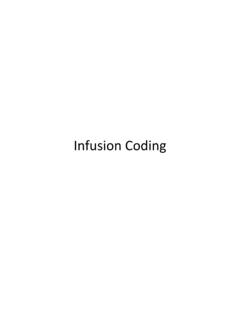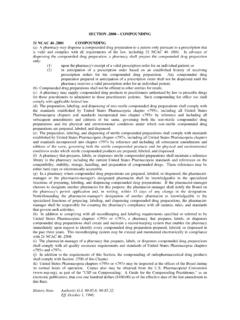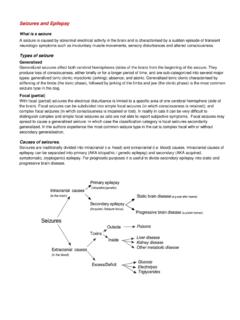Transcription of The Pathologic Classification of Neuroendocrine …
1 The Pathologic Classification of Neuroendocrine TumorsA Review of Nomenclature, Grading, and Staging SystemsDavid S. Klimstra, MD,* Irvin R. Modlin, MD, PhD, Domenico Coppola, MD, Ricardo V. Lloyd, MD, PhD, and Saul Suster, MD||Abstract: Neuroendocrine tumors (NETs) arise in most organs of thebody and share many common Pathologic features. However, a variety ofdifferent organ-specific systems have been developed for nomenclature,grading, and staging of NETs, causing much confusion. This reviewexamines issues in the Pathologic assessment of NETs that are commonamong primaries of different sites.
2 The various systems of nomenclatureare compared along with new proposal for grading and staging differences persist, there are many common themes, such asthe distinction of well-differentiated (low and intermediate-grade) frompoorly differentiated (high-grade) NETs and the significance of prolif-erative rate in prognostic assessment. A recently published minimumpathology data set is presented to help standardize the information inpathology reports. Although an ultimate goal of standardizing thepathologic Classification of all NETs, irrespective of primary site,remains elusive, an understanding of the common themes among thedifferent current systems will permit easier translation of informationrelevant to prognosis and Words: Neuroendocrine tumor, NET, pathology, Classification ,grade, stage(Pancreas2010.)
3 39: 707Y712) Neuroendocrine neoplasms, defined as epithelial neoplasmswith predominant Neuroendocrine differentiation, arise inmost organs of the ,22 Some of the clinical and pathologicfeatures of these tumors are characteristic of the organ of origin,but other attributes are shared by Neuroendocrine neoplasmsirrespective of their anatomic site. In general, studies of neuro-endocrine neoplasms have concentrated on tumors of a specificorgan system such as the lung, the pancreas, or the gastrointes-tinal tract. For this reason, various proposals have appeared re-garding the Classification and nomenclature of neuroendocrinetumors (NETs), and many of these differ somewhat in the use ofspecific terminology and criteria for grading and systems have indeed proven useful to stratify prog-nostic subgroups of NETs.
4 However, the differences in criteriahave resulted in much confusion, especially because morpho-logically similar tumors may be designated differently depend-ing on the site of origin, and some of the terminology used in onesystem suggests markedly different tumor biology based onanother system. It would be of great benefit for the prediction ofoutcome and the determination of therapy if a single system ofnomenclature, grading, and staging could be developed forNETs of all anatomic sites, and there are many similaritiesamong NETs throughout the body. However, a number of thesystems that have arisen independently are now firmly estab-lished and recognized by organizations charged with standard-izing terminology, such as the World Health Organization(WHO).
5 Also, compelling clinical data favoring one system overanother do not exist. Thus, abandoning some of the currentsystems in favor of a single, uniform proposal has proven im-practical. On the other hand, careful examination of the existingproposals reveals many common features that underlie theclassification and form the basis for grading and such as the proliferative rate of the tumor and the extentof local spread (assessed based on similar parameters used fornon- Neuroendocrine carcinomas of the same anatomic sites) areshared by most systems. Therefore, it is recommended that thesebasic data elements used to stratify NETs be specified anddocumented in pathology reports, in addition to the use of aspecified system of nomenclature, grading, and staging.
6 Bydoing this, we assure that the fundamental data necessary forprognostic assessment and therapy determination are recorded,allowing retrospective comparison of the characteristics ofNETs irrespective of the specific Classification system that maycurrently be in vogue. Recently, a multidisciplinary consensusgroup of experts in the field of NETs has recommended suchan approach and has developed aminimum pathology data set(Table 1) of features to be included in pathology of American Pathologists (CAP) has also developedsimilartumor checklistsfor NETs that specify many of the ISSUESOne semantic issue relates to the use of the termendocrineversusneuroendocrine.
7 Originally, the concept ofneuroendo-crineneoplasia reflected the hypothesis that the cells from whichthese tumors were derived originated from the embryonic neuralcrest. This concept was disproved years ago, causing someauthorities to advocate abandoning the termneuroendocrineinfavor ofendocrine, to reflect that most of these epithelial neo-plasms recapitulated cells of endodermal origin. However, theneoplastic cells also possess features of neural and epithelialcells, and for this reason, the most recent edition of the WHOclassification of tumors of the digestive system has once againrecommended the use there maybe arguments favoring either term, it must be recognized thatthey are essentially synonymous, and both are widely under-stood.
8 For the sake of uniformity,neuroendocrinewill be usedthroughout this manuscript. Another debated terminologicalissue relates to the use oftumorinstead ofneoplasm. Certainly,all of the entities under discussion are neoplastic , andneoplasmis therefore a more accurate term thantumor, which means onlya mass. However, Neuroendocrine tumor (NET)has achievedNANETSGUIDELINESP ancreas&Volume 39, Number 6, August the *Department of Pathology, Memorial Sloan-Kettering CancerCenter, New York, NY; Department of Surgery, Yale University School ofMedicine, New Haven, CT; Anatomic Pathology Department, MoffittCancer Center, Tampa, FL; Department of Pathology and LaboratoryMedicine, University of Wisconsin School of Medicine and Public Health,Madison, WI; and ||Department of Pathology, Medical College of Wisconsin,Milwaukee, : David S.
9 Klimstra, MD, Department of Pathology, MemorialSloan-Kettering Cancer Center, 1275 York Ave, New York, NY 10065(e-mail: by Lippincott Williams & WilkinsCopyright 2010 Lippincott Williams & Wilkins. Unauthorized reproduction of this article is acceptance in many systems and will be used here inlieu of the more correct but less accepted alternative,neuroen-docrine terminology for NETs varies by anatomic site. The useof the termcarcinoid tumorhas been repeatedly criticized8,32because of concerns that the term does not adequately conveythe potential for malignant behavior that accompanies many ofthese neoplasms.)
10 However,carcinoid tumorremains in use,both in the official WHO Classification of NETs of the lung34andas a synonym for NETs of other sites that retains widespreadcolloquial general, Neuroendocrine neoplasms are divided into well-differentiated and poorly differentiated categories. The con-cept of differentiation is linked to the grade of the tumors, butTABLE Pathology Data Set: Information to beIncluded in Pathology Reports on NETs (from Klimstra et al2010)17 For resection of primary tumors:Anatomic site of tumorDiagnosis (functional status need not be included in the pathology report)Size (3 dimensions)Presence of unusual histologic features (oncocytic, clear cell,gland-forming, and other features)Presence of multicentric disease[OPTIONAL.]









